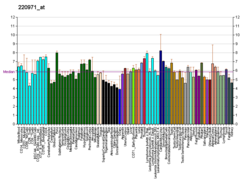Top Qs
Timeline
Chat
Perspective
Interleukin 25
Cytokine that belongs to the IL-17 cytokine family From Wikipedia, the free encyclopedia
Remove ads
Interleukin-25 (IL-25) – also known as interleukin-17E (IL-17E)[5] – is a protein that in humans is encoded by the IL25 gene on chromosome 14.[6][7][8] IL-25 was discovered in 2001 and is made up of 177 amino acids.[6]
Remove ads
IL-25 and IL-17 family
IL-25 is a cytokine that belongs to the IL-17 cytokine family together with IL-17A (named also IL-17), IL-17B, IL-17C, IL-17D and IL-17F. This is why IL-25 has the alternative name IL-17E. All members have homologous amino acid sequence segments and spatially conserved cysteines. It is the IL-25 that differs from other members in its function and structure.[9]
IL-25 signals through a heterohexameric receptor complex containing IL-17RA and IL-17RB. In this complex, IL-25 forms a homodimer with IL-17RB, which then binds to IL-17RA.[10] The IL-17RA subunit is common for IL-17A and IL-17F, and IL-17RB is common for IL-17B. Both IL-17RA and IL-17RB are essential for IL-25 functions. IL-25 does not bind directly to IL-17RA, but this subunit is necessary for its functions - as well as IL-17RB which directly bind IL-25.[11][12]
Remove ads
Function
Summarize
Perspective
IL-25 is produced by many cell types. These cells include T cells, dendritic cells, macrophages, mast cells, basophils, eosinophils, epithelial cells and Paneth cells.[13][14]
This cytokine can induce NF-κB activation, and stimulate the production of IL-8 (named also CXCL8), which is the major chemotactic substance of neutrophils.[6]
Another important function of interleukin 25 is to support the Th2 immune response. IL-25 has been shown to induce the production of IL-4, IL-5 and IL-13.[7] Evidence is the expression of IL-17RB on Th2 cells, not on Th1 and Th17.[15] In addition, IL-25 is responsible for the decrease in IFN gamma.[15][16]
Because IL-25 promotes the development of a Th2 immune response, it acts to protect against several bowel infections caused by helminths.[16][17] This role of IL-25 has been demonstrated in these intestinal parasites - Nippostrongylus brasiliensis [18], Trichuris muris [16], Trichinella spiralis [19] and Heligmosomoides polygyrus bekeri. [17]
IL-25 is also referred to as the regulator of IL-9 production. IL-25 has been shown to increase the production of IL-9 in Th9 cells. Th9 cells can arise not only from naive T cells but also from differentiated Th2 cells.[20]
Another function of IL-25 is the activation of natural lymphoid cells 2 (ILC2). IL-25 and IL-33 are the most potent activators of ILC2.[21][22]
Remove ads
Clinical significance
IL-25 induces the production of other cytokines, including IL-4, IL-5 and IL-13 in multiple tissues, which stimulate the expansion of eosinophils. This cytokine is an important molecule controlling immunity of the gut[16] and has been implicated in chronic inflammation associated with the gastrointestinal tract. IL-25 can kill some types of breast cancer cells. [23]
Further, the IL-25 gene has been identified in a chromosomal region associated with diseases of the gut such as inflammatory bowel disease (IBD), although no direct evidence suggests that IL-25 plays any role in this disease.[24]
IL-25 has potent antitumor activity in vivo in several human cancers including melanoma, breast, lung, colon, and pancreatic cancers, suggesting the potential clinical use of IL-17E as an anticancer agent.[25]
IL-25 and allergy
IL-25 works pathologically in allergies. It is a cytokine that supports the Th2 response. IL-25 induces IL-4, IL-5 a[clarification needed] IL-13, cytokines which play important role in allergies.[7][26]
Many studies suggest that blocking IL-25 activity might be useful in the treatment of allergies. Research studies suggest the blocking of IL-25 activity by the neutralizing antibody against IL-25. A delayed Th2 differentiation and delayed production of cytokines IL-4, IL-5 and IL-13 have been demonstrated in the IL-25 knockout mouse.[18]
IL-25 influences the development of nasal polyps, and may also be involved in the etiology of chronic rhinitis with nasal polyps. A 2018 study found that after using a non-neutralizing antibody against IL-25, IL-4, IL-5, and IL-13 decreased, and the number of nasal polyps decreased.[27]
Another proposed option of treating allergies with IL-25 is a combination of neutralizing antibodies against IL-25, IL-33 and TSLP (thymic stromal lymphopoietin). All three of these cytokines support the Th2 immune response.[28]
Remove ads
References
Further reading
Wikiwand - on
Seamless Wikipedia browsing. On steroids.
Remove ads





